| Image | Plant | Status | Notes | Events |
|---|---|---|---|---|
| Broad-Leaved Mustard (Brassica juncea 'Miike Giant') |
Have 1 Veg 10 Veg |
https://www.kitazawaseed.com/s... Sow: Oct 1; Jan 15 – Apr 1 Germination: 4-5 days Maturity: 40-50 days |
October 20, 2021: Seeds sown October 22, 2021: Seeds germinated February 3, 2023: Seeds sown May 20, 2023: Plant Ended (Removed, Died, Discarded, etc) |
|
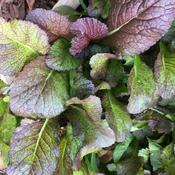 |
Mustard Greens (Brassica juncea 'Red Giant') |
Have Red Winter Garden 1 Veg 8 Veg 9 Veg 10 Veg |
Cold hardy to 25F degrees https://www.kitazawaseed.com/s... Sow: Jan 15-Apr 1; Aug 15-Oct 1 Germination: 4-10 days Maturity: 40-50 days |
May 19, 2021: Harvested September 12, 2021: Seeds sown September 15, 2021: Seeds germinated October 3, 2021: Seeds sown October 9, 2022: Seeds sown February 3, 2023: Seeds sown April 21, 2023: Harvested May 20, 2023: Plant Ended (Removed, Died, Discarded, etc) September 9, 2023: Seeds sown September 16, 2023: Seeds germinated October 26, 2023: Seeds sown November 12, 2023: Seeds sown (Greenhouse) March 2, 2024: Transplanted |
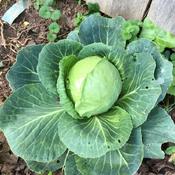 |
Cabbage (Brassica oleracea 'Early Round Dutch') |
Prev 1 Veg 8 Veg |
Use Insect Netting sets Jan 15-Mar 15; Aug 1-Oct 1 |
May 19, 2021: Harvested |
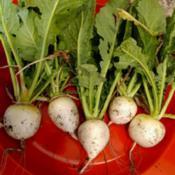 |
Turnip (Brassica rapa 'Hakurei') |
Have 1 Veg 9 Veg |
EARLY WHITE JAPANESE TURNIP Hybrid "very fast-growing and tender" uniform with "short hairless tops" "excellent sweet and mild flavor that makes it a favorite salad ingredient." https://www.kitazawaseed.com/s... sow: Oct 1-Dec 1 Germination: 4-7 days Maturity: 30 - 38 days Cold Hardy to 10 degrees Young, radish-size turnips are ready in about 30 days; full-size turnips are ready in about 40–50 days. Roots are smoothest when small. |
|
| Turnip (Brassica rapa 'Hidabeni') |
Have 1 Veg 9 Veg |
https://www.kitazawaseed.com/s... Sow: Jan 15-Apr 1; Sep1-Sep 15 Germination: 2-10 days Maturity: 45-50 days |
September 9, 2023: Seeds sown September 16, 2023: Seeds germinated October 12, 2023: Harvested (Greens) |
|
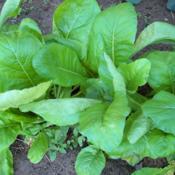 |
Mustard Spinach (Brassica rapa subsp. nipposinica 'Tendergreen') |
Prev 1 Veg 10 Veg |
https://www.botanicalinterests... Sow Jan 15-Mar 15; Aug 1-Oct 1 |
August 23, 2020: Seeds sown October 3, 2020: Seeds sown November 8, 2020: Harvested August 7, 2021: Seeds sown October 9, 2022: Seeds sown February 3, 2023: Seeds sown April 21, 2023: Harvested |
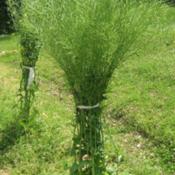 |
Turnip (Brassica rapa subsp. rapa 'Seven Top') |
Have 1 Veg 10 Veg |
https://www.edenbrothers.com/s... Sow: Jan 15–Apr 1; Aug 10 – Sep 15 Germination: 7-14 days Maturity: 30-60 Days |
October 16, 2021: Seeds sown May 20, 2023: Plant Ended (Removed, Died, Discarded, etc) |
| Curly Endive (Cichorium endivia 'Tres Fine Maraichere') |
Have 1 Veg 10 Veg |
Fall: ***** sow: Oct 1 (soil temp below 78 deg) Sow: Jan 1 germination: 10-14 days maturity: 55 days https://www.botanicalinterests... |
October 3, 2021: Seeds sown October 13, 2021: Seeds germinated September 5, 2022: Seeds sown |
|
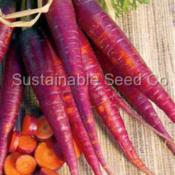 |
Carrot (Daucus carota var. sativus 'Cosmic Purple') |
Have 1 Veg 9 Veg |
Botanical Interest Germination: 10-25 days Maturity: 70 days "Carrots are a cool season crop, with optimal growth between 60°-65°F, with a minimum of 45°F and a maximum of 75°F. Fall crops can be started in the heat of late summer to ensure that a substantial period of cool weather exists before frost. Color development is determined by temperature. Maximum color development occurs in the 60°-75°F optimal growth range. Temperatures over 70°F will also reduce root length, while temperatures below 60°F will produce longer roots. " UGA Crop Profile for Carrots "Purple carrots were prevalent in European and Middle Eastern markets until the orange carrot's introduction...Purple carrots originated over five thousand years ago in present-day Afghanistan in Central Asia. Considered to be one of the original carrots to be domesticated, many natural hybrids and mutants were developed and crossed with wild and cultivated varieties creating new cultivars varying in core color, size, and flavor. Purple carrots were then transported via seeds across Africa, Europe, and Eastern Asia and were sold during trade expeditions. Today Purple carrots are found at local farmers markets, specialty grocers, and in home gardens in North America, South America, Africa, Europe, Asia, and Australia. " - Specialty Produce Produces 6"–7" long conical roots with long tapered ends, purple skin and orange core. Cross between imperator and nantes types. Care should be taken to harvest carrots at optimum for the particular market because over-mature carrots can develop woody centers particularly in older varieties. Over-mature carrots are also more prone to breakage during harvest. However, delaying harvest by 7-10 days after the appropriate size has been reached will increase the sugar content in mild climatic conditions. Thus, it may be better to delay harvest by one to two weeks depending on the weather. Carrot (Daucus carota var. sativus) is a member of the Umbelliferae family. Other vegetable crops and herbs in this family include celery, parsnip, parsley, dill, caraway, anise, coriander and fennel. Domestic carrots may have evolved from a wild form similar to its relative known in North America as Queen Anne's Lace. The family name comes from the flower form, which is an umbel. Characteristic of most of the family's plants, an umbel has individual flower stalks originating from the same point on the stem. Carrots probably originated in Asia around northwest India. Cultivation of carrots for medicinal purposes began 2000 to 3000 years ago. They were used for a myriad of medicinal purposes including stomach ulcers, abscesses, bladder, liver and kidney problems, to aid in childbirth and even as aphrodisiacs. Cultivation of roots for consumption dates back to 600 A.D. when purple root types were grown in the area currently known as Afghanistan. Yellow types were eventually selected and produced in Syria and Iran in the ninth or tenth century. Carrots were introduced to China by the thirteenth century and cultivation spread from the Middle East to Italy, Spain and throughout Europe by the fourteenth century. Eventually, white and orange types were selected. Orange types, first grown in the Netherlands during the seventeenth century, were brought to North America by early settlers. The root was popular with Native Americans and production currently exists worldwide. One of the reasons production is so widespread is that carrots are the major single source of Vitamin A in the diets of many cultures. They are also a good source of other vitamins, minerals and fiber. https://extension.uga.edu/publ... Serving fresh in salads or vegetable platters, light sautéing or roasting showcases the dramatic colors. "The carrots can also be lightly sautéed or roasted to develop a sweet, caramelized flavor. Leafy tops of carrots can be blended into sauces, minced into salads, or lightly sautéed and served as a side dish. Purple carrots pair well with pomegranate seeds, hazelnuts, radishes, tomatoes, cheeses such as pecorino, cheddar, and parmesan, garlic, ginger, mushrooms, and potatoes." Avoid storing carrots with fruits, as fruits produce an ethylene gas which may make the carrots bitter. https://www.botanicalinterests... |
February 20, 2022: Seeds sown October 9, 2022: Seeds sown February 3, 2023: Seeds sown May 20, 2023: Harvested |
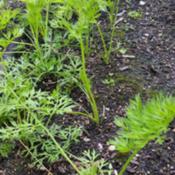 |
Carrot (Daucus carota var. sativus 'Little Fingers') |
Have 1 Veg 9 Veg |
Fall **** https://www.kitazawaseed.com/s... Sow: Jan 15-Mar 20; Aug 20-Sep 15 Germination: 8-10 days Maturity: 55-60 days |
March 11, 2021: Seeds sown May 8, 2021: Plant Ended (Removed, Died, Discarded, etc) August 7, 2021: Seeds sown September 12, 2021: Seeds sown October 9, 2022: Seeds sown |
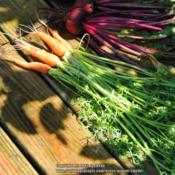 |
Asian Carrot (Daucus carota var. sativus 'Shin Kuroda') |
Have 1 Veg |
Botanical Interest Fedco Maturity: 75 days |
February 20, 2022: Seeds sown February 3, 2023: Seeds sown May 20, 2023: Harvested May 20, 2023: Harvested |
| Lettuce (Lactuca sativa 'Okayama Salad') |
Have 1 Veg 10 Veg |
https://www.kitazawaseed.com/s... Sow: Jan 15-Mar 1; Oct 15 Germination: 2-10 days Maturity: 55 days |
October 21, 2021: Seeds sown October 9, 2022: Seeds sown January 20, 2024: Seeds sown March 23, 2024: Plant Ended (Removed, Died, Discarded, etc) |
|
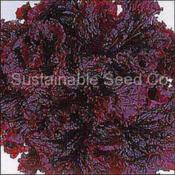 |
Lettuce (Lactuca sativa 'Red Velvet') |
Have 1 Veg 9 Veg |
||
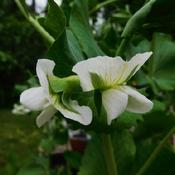 |
Snap Pea (Lathyrus oleraceus 'Cascadia') |
Prev 1 Veg 2 Veg 9 Veg 10 Veg |
BUSH PEA - vines to 30" Fedco HD https://www.homedepot.com/p/Bu... Sow: Jan-Feb; Sept-Oct Germination: 7-14 days Maturity: 58-65 days Culture: Sow as early as ground can be worked for best yields. Minimum soil temperature for pea seed germination: 40°. Optimal range 50–75°. Peas are legumes with moderate fertility requirements. Avoid excess nitrogen: they can fix their own. Use Legume Inoculant at planting. They prefer cool, moist weather and dislike dry heat. All peas produce more when staked; varieties over 2½' must be supported. Use either Trellis Netting or chicken wire. Install support at planting time to avoid disturbing seedlings. Plant 8–10 seeds/ft on each side of supports in double rows. Set supports for rows 3' apart (5' if very tall varieties). Young plants are very hardy but frost stops production at the blossom or pod stage. If you love peas as much as we do, try for a second crop in the fall. Timing is crucial, as peas ripen slowly in the cool of September, and frost will halt production. We recommend planting the first two weeks of July for a fall crop in central Maine. Warmer areas try later July. If the summer is hot, cool the soil with a hay mulch in advance of planting, or shade peas with tall crops to hold in soil moisture. Peas are 25% sucrose by weight and lose nearly half their sugars within 6 hours at room temperature. That's why they taste best grazed right off the vine. Keep cool and shell as soon as possible after picking for freezing. Not well adapted to southern climates where the spring heats up too quickly. Pam Dawling in Virginia has great success with Sugar Ann but cannot grow the tall longer-season Sugarsnap in her climate. Smooth-seeded peas germinate better in colder soils than wrinkle-seeded peas, but are not as sweet. Dawling suggests that forsythia flowering signals time to sow snap and snow peas. |
February 22, 2022: Seeds sown |
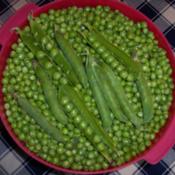 |
English Pea (Lathyrus oleraceus 'Green Arrow') |
Have 1 Veg 9 Veg |
BUSH PEA Fedco https://www.seedsavers.org/gre... Sow: Jan 15 – Feb 15; Sep Germination: 7-14 days Maturity: 60-70 days (65 days) Open-pollinated. The pea preferred by commercial growers, always on target for heavy yields. Sets the standard for midseason varieties. Long pods with up to 10 peas per pod (more typically 7–8) on vines up to 3'. Seems to withstand miserable and extreme weather better than other varieties. Easy-to-pick because pods tend to set in pairs at the top. Tolerant to F, DM, CTV, W. May have up to 11% taller off-types |
September 11, 2021: Seeds sown February 20, 2022: Seeds sown March 24, 2022: Seeds sown January 29, 2023: Seeds sown |
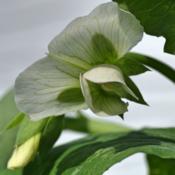 |
Snap Pea (Lathyrus oleraceus 'Sugar Ann') |
Have 1 Veg |
BUSH PEAS Sow: Jan 15-Feb 15; Possible Fall Crop - sow before Labor Day Germination 6-10 days Maturity: 58 Days Sweetest of the dwarf snap peas and earliest snap pea. Not as heavy-yielding as tall Sugarsnap. Use the 2' vines to start the season.Mulch with straw 1983 Silver All-America winner bred by Calvin Lamborn and named for one of his daughters. Resistant to Wilt. Still has a small percentage of off-types. Don't pick snap peas too soon: snaps taste sweetest when completely filled out. inimum soil temperature for pea seed germination: 40°. Optimal range 50–75°. Peas are legumes with moderate fertility requirements. Avoid excess nitrogen: they can fix their own. Use legume inoculant at planting. They prefer cool, moist weather and dislike dry heat. All peas produce more when staked; varieties over 2½' must be supported. Use either Trellis Netting or chicken wire. Install support at planting time to avoid disturbing seedlings. Plant 8–10 seeds/ft on each side of supports in double rows. Set supports for rows 3' apart (5' if very tall varieties). Young plants are very hardy but frost stops production at the blossom or pod stage. If you love peas as much as we do, try for a second crop in the fall. Timing is crucial, as peas ripen slowly in the cool of September, and frost will halt production. We recommend planting the first two weeks of July for a fall crop in central Maine. Warmer areas try later July. If the summer is hot, cool the soil with a hay mulch in advance of planting, or shade peas with tall crops to hold in soil moisture. Peas are 25% sucrose by weight and lose nearly half their sugars within 6 hours at room temperature. That's why they taste best grazed right off the vine. Keep cool and shell as soon as possible after picking for freezing. Varieties quickest to maturity are best bet for southern climates where the spring heats up too quickly. Smooth-seeded peas germinate better in colder soils than wrinkle-seeded peas, but are not as sweet. Pam Dawling suggests that forsythia flowering signals time to sow snap and snow peas. https://www.gardeningknowhow.c... |
October 14, 2022: Seeds sown January 2, 2023: Plant Ended (Removed, Died, Discarded, etc) September 4, 2023: Seeds sown September 9, 2023: Seeds germinated |
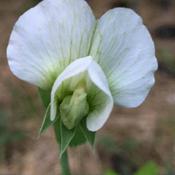 |
Snap Pea (Lathyrus oleraceus 'Sugar Daddy') |
Prev 1 Veg 9 Veg |
Sow: Jan 15-Feb 15; Sep 15-Oct 15 Germination: 7-14 days Maturity: 65 days - Thanksgiving |
August 23, 2020: Seeds sown September 11, 2021: Seeds sown |
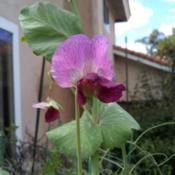 |
Sugar Snap Pea (Lathyrus oleraceus 'Sugar Magnolia') |
Prev 1 Veg 2 Veg |
CLIMBING SNAP PEA Snap peas have both crisp, sweet, edible pods and tender peas to be enjoyed steamed, stir-fried, or raw. All parts of the peas (Pisum sativum) plant are edible, too, including flowers, tendrils, and pea shoots. Sow: Jan; Sept-Oct 70 days. https://www.kitchengardenseeds... This brilliant, beautiful new tendril Snap Pea features bicolored pink and purple-red flowers and deep bluish-purple pods that add an extra dash of flair to both the veggie garden and crudité platters. The pods are sweetest when picked before they fatten to their maximum size. Vines grow up to 8 feet tall and cling tightly to any trellis. (OP.) Germination: 5-10 days Maturity: 70 days Sugar Magnolia' isn't just a famous Grateful Dead song, it is also a beautiful, fine-flavored, edible-pod pea with purple flowers. Long hypertendrils (vigorous, multi-branching tendrils) act as extra sturdy supports for 6'-7' vining plants, creating an airy structure that helps prevent mildew. Some of these open-pollinated peas may be speckled with green, or be fully green. RECOMMENDED. 4 to 6 weeks before your average last frost date, when soil temperature is at least 40°F, ideally 60°–80°F and again 10 to 12 weeks before your average first frost date. In Mild Climates, sow in fall or winter for winter harvest. Best grown in temperatures less than 85°F. It isn't absolutely necessary, but seeds can be treated before sowing with an inoculant, called rhizobia, that are bacteria that work with pea roots to create nitrogen, an important nutrient for plant growth. Once applied, the inoculant can live on in the soil from year to year, but it may be beneficial to add it when planting peas in an area where they have not been grown in 3 to 5 years, or in acidic soils where inoculant may not survive. |
February 20, 2022: Seeds sown March 24, 2022: Seeds sown June 6, 2022: Plant Ended (Removed, Died, Discarded, etc) September 5, 2022: Seeds sown January 2, 2023: Plant Ended (Removed, Died, Discarded, etc) January 29, 2023: Seeds sown |
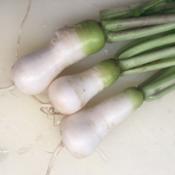 |
Radish (Raphanus sativus 'Altari Dochon 89') |
Have 1 Veg 9 Veg |
PONYTAIL RADISH Source: https://www.kitazawaseed.com/s... Source: https://kimchimarishop.com/pro... Sow: Sept 1-Oct 15; Jan 15-Apr 1 Germination: 4 days Germination Temp: 55-70°F Maturity: 55-60 days (spring), 35-40 days (fall) Recipe: https://kimchimari.com/radish-... https://theprudentgarden.com/c... Altari radish kimchi, also known as Chonggak kimchi, is popular in Korea. Altari radish grown in the fall are preferred, as they are sweeter and less pungent. Radishes get their sweetness from glucose and fructose. Kimchi for Bachelors Chonggak translates to bachelor in Korean. This kimchi got it's name because the radish used for the kimchi resembles a ponytail. Back in the old days in Korea, young men wore their hair in a long braid. Because the radish stem resembles the braid, the Altari radish was nicknamed bachelor, or Chonggak. Whether or not it is a favorite of bachelors, this particular kimchi is my favorite and very popular in Korean cuisine. |
March 11, 2021: Seeds sown May 22, 2021: Harvested September 11, 2021: Seeds sown September 15, 2021: Seeds germinated September 19, 2022: Seeds sown January 2, 2023: Harvested September 9, 2023: Seeds sown September 14, 2023: Seeds germinated |
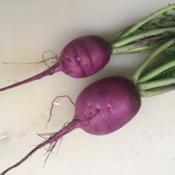 |
Radish (Raphanus sativus 'Bora King') |
Have 1 Veg 9 Veg |
https://www.kitazawaseed.com/s... Sow: Sept 1-Oct 15; Jan 15-Apr 1 Germination: 3-10 days Maturity: 60 days https://www.foodfidelity.com/b... https://holycowvegan.net/mooli... Radish " Korean Radish Bora King, Hybrid Raphanus sativus This beautiful daikon has purple flesh and skin. It matures at 8-10" long, weighs 2-3 lbs, and has late pithiness. The plant is slow to bolt, and the leaves are deeply serrated and delicious. An excellent variety for specialty market growers. Cool season Approx. 100-200 seeds in packet. Maturity: Approx. 60-65 days Planting season: Spring or fall Cultivation: Prepare fertile, well-drained soil. Sow seeds in spring after last frost or in late summer/early fall in a warm, sunny location. Keep soil moist. Fertilize as needed. Germination Temperature 55-70°F Seed Depth 1/2" Seed Spacing 1" Thin To 4-6" Row Distance 18-24" Please note: Maturity, adaptability and disease tolerance may differ under your specific climate and/or growing conditions. Culinary tips: Use in soup, salad, tsukemono (pickled) or fresh. Daikon oroshi (coarsely grated daikon using a Japanese grater) is delicious in sauces used for soba noodles, tempura, and sashimi. The leaves are eaten as well. |
March 11, 2021: Seeds sown May 22, 2021: Harvested September 12, 2021: Seeds sown September 15, 2021: Seeds germinated September 19, 2022: Seeds sown January 2, 2023: Harvested September 9, 2023: Seeds sown September 14, 2023: Seeds germinated |